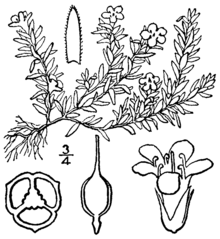Pyxidanthera
| Pyxidanthera | |
|---|---|

| |
| Pyxidanthera barbulata | |
| Scientific classification | |
| Kingdom: | Plantae |
| Clade: | Tracheophytes |
| Clade: | Angiosperms |
| Clade: | Eudicots |
| Clade: | Asterids |
| Order: | Ericales |
| Family: | Diapensiaceae |
| Genus: | Pyxidanthera Michx. |
| Species | |
Pyxidanthera is a genus of flowering plant in the family Diapensiaceae. Though often recongnized as two species, Pyxidanthera barbulata and Pyxidanthera brevifolia, these designations are not genetically or morphologically distinct.[1][2] Furthermore, these two designated species were found to not be reciprocally monophyletic.[3][4][5]
Despite these findings, some flora still recognize these two species based on their range, habitat, and leaf morphology (size and pubescence).[4][6] However, these leaf morphology differences are directly related to habitat and moisture.[7] Despite the species designations being based on habitat and moisture, climatic niche differentiation is not found between the two species.[8] Therefore, these species designations are strictly based on range, despite the overlapping range of the two species. The most widespread species, Pyxidanthera barbulata, is native to the eastern United States, occurring on the coast from Long Island to New Jersey and Virginia to South Carolina.[9][4] A second species of Pyxidanthera[10] called Pyxidanthera brevifolia, known only from North and South Carolina.[11]
References
[edit]- ^ Godt, MJW; Hamrick, J (1995). "Low levels of allozyme differentiation between Pyxidanthera (pyxie-moss) taxa (Diapensiaceae)". Plant Systematics and Evolution. 195 (3–4): 159-168. Bibcode:1995PSyEv.195..159G. doi:10.1007/BF00989292.
- ^ Wall, Wade A.; Douglas, Norman A.; Xiang, Qiu-Yun Jenny; Hoffmann, William A.; Wentworth, Thomas R.; Hohmann, Matthew G. (6 September 2010). "Evidence for range stasis during the latter Pleistocene for the Atlantic Coastal Plain endemic genus, Pyxidanthera Michaux: EVIDENCE FOR RANGE STASIS IN THE GENUS PYXIDANTHERA". Molecular Ecology. 19 (19): 4302–4314. doi:10.1111/j.1365-294X.2010.04793.x. PMID 20819166.
- ^ Gaynor, Michelle L.; Fu, Chao-Nan; Gao, Lian-Ming; Lu, Li-Min; Soltis, Douglas E.; Soltis, Pamela S. (September 2020). "Biogeography and ecological niche evolution in Diapensiaceae inferred from phylogenetic analysis". Journal of Systematics and Evolution. 58 (5): 646–662. doi:10.1111/jse.12646.
- ^ a b c Pyxidanthera barbulata. Archived 2011-10-26 at the Wayback Machine Center for Plant Conservation.
- ^ Rönblom, K. and A. A. Anderberg. (2002). Phylogeny of Diapensiaceae based on molecular data and morphology. Systematic Botany 27(2) 383-95.
- ^ Wells, B (1929). "A new pyxie from North Carolina". Journal of the Elisha Mitchell Scientific Society. 44: 238–239.
- ^ Primack RB, RB; Wyatt, R (1975). "Variation and taxonomy of Pyxidanthera (Diapensiaceae)". Brittonia. 27 (2): 115-118. Bibcode:1975Britt..27..115P. doi:10.2307/2805470. JSTOR 2805470.
- ^ Gaynor, Michelle L.; Fu, Chao-Nan; Gao, Lian-Ming; Lu, Li-Min; Soltis, Douglas E.; Soltis, Pamela S. (September 2020). "Biogeography and ecological niche evolution in Diapensiaceae inferred from phylogenetic analysis". Journal of Systematics and Evolution. 58 (5): 646–662. doi:10.1111/jse.12646.
- ^ Pyxidanthera barbulata. The Nature Conservancy.
- ^ The Plant List
- ^ Pyxidanthera brevifolia. Flora of North America.
